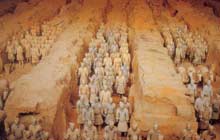
 Xi'an and its surrounding area is at the very heart of China's history. This city served as the capital seat of twelve dynasties for more than 1100 years, and its Wei valley is the legendary birthplace of Chinese civilization. It was here that the mythical Yellow Emperor (third millennium BC) conquered the other warring tribes to give birth to the Chinese nation.
Xi'an and its surrounding area is at the very heart of China's history. This city served as the capital seat of twelve dynasties for more than 1100 years, and its Wei valley is the legendary birthplace of Chinese civilization. It was here that the mythical Yellow Emperor (third millennium BC) conquered the other warring tribes to give birth to the Chinese nation.
Over the centuries successive capitals have changed their names and locations, as well as their characters. The remains of Gaojing, the capital during the Western Zhou dynasty (1027-771 BC), consist of crude bronze artifacts for cooking, burial and farming. They reflect an early agricultural society. This is in contrast to the despotic Emperor Qinshihuang's (r. 221-207 BC) Xianyang, a capital city erected twenty-eight km west of modern day Xi'an. Built on a scale to befit such a tyrant, it came to be detested by the people as a symbol of his oppressive and short-lived regime.
The Western Han dynasty (206BC-8AD) moved the capital to within ten kilometres of Xi'an. It was during this prosperous period that Chang'an, as it was then known, rose to international prominence. A century after the opening of the Silk Road, Julius Caesar appeared one evening at the theater wearing a garment that caused a sensation – it was a silk robe from Chang'an. Silk, paper, tea, iron casting and irrigation were other inventions similarly exported to the West at this time.
After the Eastern Han dynasty (8-220 AD) transferred the imperial capital to Luoyang, it didn't return to Xi'an until China was once more reunified under the Sui dynasty (589-618). Once more the grandiose schemes of a despotic, conquering Emperor were curtailed by a dynasty more amenable to the people. During the golden age of the Tang dynasty (618-907), when China led the world in culture, technology and wealth, Chang'an became a focus for new ideas. A vast and splendid city of eighty square km, only twenty less than today's industrialized city, it contained a two million strong population. So beautiful were its buildings and orderly its design that the Japanese used Chang'an as the model for the still extant, smaller cities of Kyoto and Nara.
As the Tang Emperors pushed back China's frontiers more and more cultures from Central Asia, India and Persia were absorbed into the cosmopolitan capital. Besides the especially strong Buddhist community, there were also Zoroastrian, Muslim, Manichaean and Nestorian ones. The town thronged to the raucous rhythms of markets, taverns, workshops, and even polo matches.